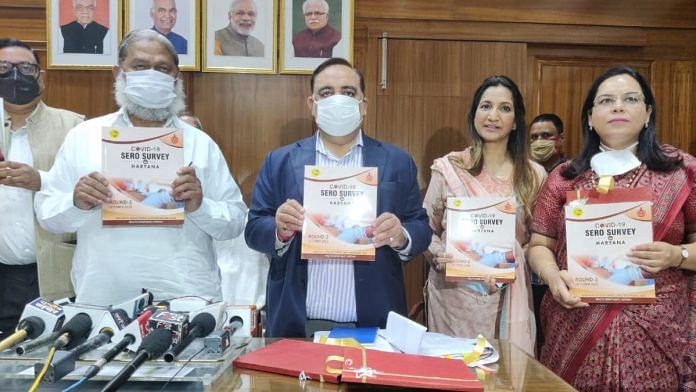Chandigarh: The second round of sero survey to assess the spread of Covid-19 in Haryana has revealed that 14.8 per cent of the state’s population has already been infected.
While this translates into more than 37 lakh people, the total number of positive cases in the state is about 1.68 lakh, pointing towards a large section of the population having gone undetected for the disease.
The findings of the sero survey were released by state Health Minister Anil Vij Monday evening. The second round of the survey was conducted in the first two weeks of October across all 22 districts of the state with a sample size of more than 700 people in each district. A total of 16,512 samples were collected from the entire state.
In the first round of the sero survey, which was conducted in August, sero prevalence of Covid-19 was 8 per cent.
In urban areas, the sero prevalence in the second round was recorded at 19.8 per cent while it was 11.4 per cent in rural areas. The division based on gender was only marginal, with women registering 14.8 per cent sero prevalence and men 14.7 per cent.
Also read: 20% of Andhra exposed to Covid, sero-survey finds, exposure highest where case tally lowest
NCR districts showed high seropositivity
The survey stated that NCR districts had high seropositivity — 31.2 per cent in Faridabad, 17.6 per cent in Nuh, 16.5 per cent in Gurugram and 13.2 per cent in Sonipat.
Urban areas of Faridabad, Yamunanagar and Panipat had the highest seropositivity rates — 40.2 per cent, 37.1 per cent and 36.3 per cent, respectively.
Among the rural areas, Faridabad and Jind registered the highest seropositivity rate of 25.5 per cent each.
The districts that registered seropositivity of less than 10 per cent were Hisar (9.7 per cent), Mahendergarh (8.6 per cent), Charkhi Dadri (7.7 per cent), Sirsa (7.5 per cent), Palwal (5.5 per cent) and Bhiwani (3.1 per cent).
Yamunanagar witnessed the highest jump in seropositivity between the two rounds — from 8.3 per cent to 28.6 per cent — followed by Jind, Panipat and Ambala.
However, Nuh, Bhiwani, Charkhi Dadri, Palwal and Sonepat districts registered a lower seropositivity in round two than in round one.
“There could be multiple reasons for this. Apart from the fact that antibodies once formed may not be detectable after sometime, there are chances that these districts were able to contain the infection better than others,” said Dr Usha Gupta, director health services, Haryana.
Profile of the respondents
Additional Chief Secretary and Principal Secretary, Health, Rajeev Arora said the survey was conducted by the health department in collaboration with the department of Community Medicine, Post Graduate Institute of Medical Sciences, Rohtak.
“A sero survey is about testing a group of individuals for presence of antibodies as it helps in understanding the number of people affected by the disease. The study helped us to determine the burden of Covid-19 at the community level in the state and monitor the trends of transmission of the infection,” he said.
Giving details of the profile of the respondents, Arora added that 61 per cent of the respondents had been wearing masks, while 39 per cent had never used a mask.
“Also, almost 95 per cent of the respondents had not shown any symptoms in the last 60 days. Among the women respondents, the majority were housewives. There was a fair share of varied respondents, including senior citizens, students, health staff, government employees, people in private jobs and businesses, labourers and farmers,” he added.
Also read: India missed close to 64 lakh Covid infections by early May, ICMR sero survey shows






